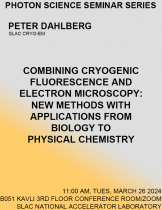SLAC: 051 Kavli 3rd Floor Conference Room; Zoom: https://stanford.zoom.us/j/92771413188?pwd=TlFRMk5WWGd5ZFRhTHliRkF6V25CZz09
Join from PC, Mac, Linux, iOS or Android: https://stanford.zoom.us/j/92771413188?pwd=TlFRMk5WWGd5ZFRhTHliRkF6V25CZz09
Password: 757758
Or iPhone one-tap (US Toll): +18333021536,,92771413188# or +16507249799,,92771413188#
Or Telephone:
Dial: +1 650 724 9799 (US, Canada, Caribbean Toll) or +1 833 302 1536 (US, Canada, Caribbean Toll Free)
Meeting ID: 927 7141 3188
Password: 757758
International numbers available: https://stanford.zoom.us/u/adYK4uveJd
Meeting ID: 927 7141 3188
Password: 757758
Password: 757758
Speaker: Peter Dahlberg, Cryo-EM
Program Description
Cryogenic electron tomography (Cryo-ET) is a powerful approach to observe subcellular architecture and can achieve near atomic resolution when specific complexes can be aligned and averaged. Despite the high-resolution obtainable by Cryo-ET, biological insight can be challenging due to a lack of contextual information. Here I will show how advanced cryogenic correlative light and electron microscopy (CryoCLEM) can be used to provide this missing information. Traditionally, CryoCLEM has focused on combining diffraction-limited fluorescence information with Cryo-ET of cellular samples. In these experiments, the low-resolution fluorescence image has primarily been used to guide the Cryo-ET acquisition to cellular regions of interest. I will discuss two new and powerful ways that fluorescence and Cryo-ET can be combined to provide a more biologically informative picture. The first approach involves the development of single-molecule-based cryogenic super-resolution fluorescence microscopy, which enables the precise locations of proteins of interest to be determined within the cellular context provided by Cryo-ET. The second approach uses ratiometric fluorescent biosensors to correlate aspects of the local environment (such as pH, ion concentrations, redox, etc.) with ultrastructural observations from Cryo-ET, providing critical chemical information for the interpretation of the observed physical structures. I will conclude with a brief perspective on the future of correlative methods and anticipated developments which will have the most profound impact on diverse fields of study.





